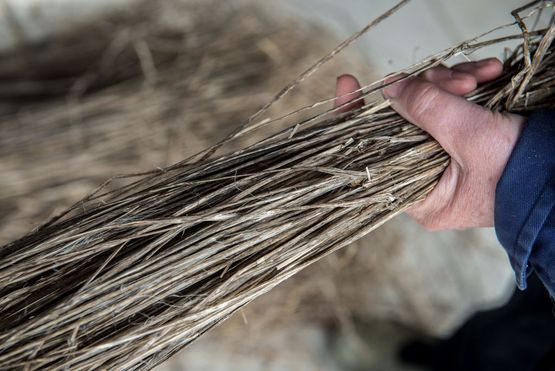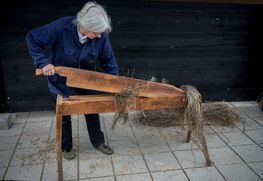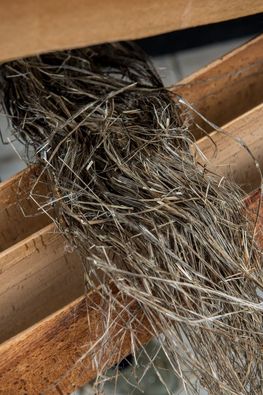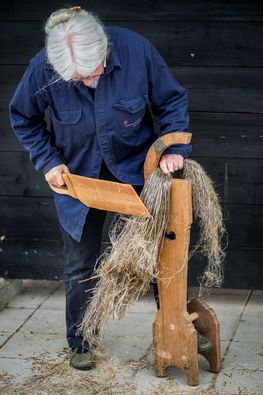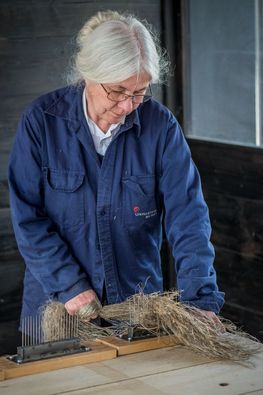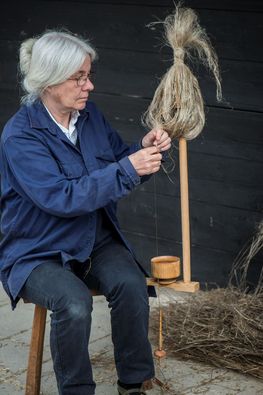From the outset, we had planned that the Gislinge Boat would have a sail made from flax. There were a number of reasons for this:
- The museum has already produced several handwoven wool sails for various previous reconstructions, so we have a good background of information against which to test a flax sail
- While there are no surviving fragments of sailcloth made from flax from archaeological excavation, there is good evidence from sites such as Næs on Sjælland, Frydenlund on Funen and Skansø in north Jutland, for the large-scale processing of flax for textile production
- There is a lot of potential data to be gained from the reconstruction and comparative testing of flax v wool sailcloth in terms of how well it performs and how long it survives
The sail should be 10m2 in size and made from five individual panels, each 65cm wide, which would be sewn together. Before the weaving and sewing can take place though, the flax fibres first have to be processed.
The flax plant is ready for harvest in August. Traditionally, it was harvested by hand, so that as much of the length of the stem remained intact as possible, thus giving the longest possible fibre. The first step involves removing the seeds from the stems, as they’ll be used to form the basis of the crop for the following year. This is done using a ripple - a type of comb with teeth set between 0.5 – 1cm apart.
The flax then needs to be retted. One method involves laying the flax in a thin layer on a meadow and turning it every second day. With retting, the flax is attacked by bacteria that break down the pith in the centre. It’s the outer layers of the flax – the bark, if you will – that contains the fibres and the pith has to be weakened to enable their extraction. The process takes 3-5 weeks, depending on the weather conditions. You can also rett by laying the flax to soak in water, but it’s important that there must be a flow of water involved – the bacteria that the process generates are poisonous, and so a still-standing pool would quickly become a threat to both domestic and wild animals.
After retting, the fibres are dried again. You can either let it dry naturally in the sun or you could use a clay oven to speed up the process: the fibres would be laid on a woven wicker mat, which was suspended over the fire. This was a risky process, however – you risk losing the crop if the temperature is not properly regulated.
When the flax is completely dry, it has to be broken. The weakened pith has to be smashed so that it can be separated from the flax fibres. Two small, blunt knife blades are set into grooves on the opposing blades of the breaking frame. You simply lift the handle and insert the stalks and then beat them downwards again and again until the stalks start to break down. In this way, the pith can be broken down into pieces ca. 1-3cm long, without incurring any damage to the fibres.
Once this is done, the flax needs to be scutched. This essentially involves a board fastened to a foot, which you stand on to secure the device. The flax fibres are laid over the board and repeatedly raked with the scutching sword. The sword isn’t used to beat the flax, rather, it’s used in a downwards, sweeping motion along the length of the fibres so that the pith is swept away.
When all of the pith is removed, you come to the last stage of the process known variously as hackling or heckling, depending on where you come from. A hackle (or heckle depending on where you come from…) is like an upended comb with teeth set into a wooden base, which can be secured to a table-top. Anna uses four different hackles with differing widths between the teeth. She begins with a rough one with teeth set ca. 1cm apart, pulling the bundles of fibres through the teeth, which removes the last of the remaining fragments of pith. This process also helps to filter out the roughest of the fibres, so that in the end you’re left with clean, workable fibres, which are now ready to be spun.
Anna gathers the fibres round a distaff and then uses a drop-spindle to tease the fibres into thread. The sail for the Gislinge Boat is quite fine in terms of quality and so the threads can’t be too coarse.
Once the threads are all spun, they’re ready to be set up on the loom and the weaving process could begin.
